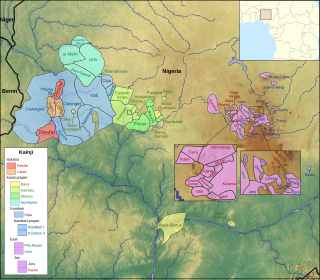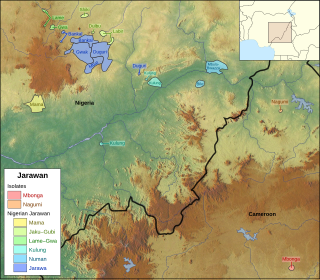Related Research Articles

Benue–Congo is a major branch of the Volta-Congo languages which covers most of Sub-Saharan Africa.
The Edoid languages are some two-to-three dozen languages spoken in Southern Nigeria, predominantly in the former Bendel State. The name Edoid derives from its most widely spoken member, Edo, the language of Benin City, which has 25 million native and secondary speakers.

There are over 525 native languages spoken in Nigeria. The official language of Nigeria is English, the language of former colonial British Nigeria. As reported in 2003, Nigerian English and Nigerian Pidgin were spoken as a second language by 100 million people in Nigeria. Communication in the English language is much more popular in the country's urban communities than it is in the rural areas, due to globalization.
Pongu (Pangu), or Rin, is a Kainji language spoken in Nigeria. There are about 20,000 speakers. Their main centre is in Pangu Gari town of Niger State, about 20 kilometres southeast of Tegina.

The Kainji languages are a group of about 60 related languages spoken in west-central Nigeria. They form part of the Central Nigerian (Platoid) branch of Benue–Congo.

Jarawan is a group of Bantu languages that are spoken spoken mostly in Bauchi State, with some also scattered in Taraba State and Adamawa State. They take their name after the Jarawan language, the most spoken language in the group.
The East Kainji languages are spoken in a compact area of the Jos Plateau in Nigeria, near Jos. There are more than 20 of them, most of which are poorly studied.
Idun (Idũ), or Dũya, is a poorly attested Plateau language of Nigeria. Its classification is uncertain, but it may be closest to Ashe.
The Kamuku languages are a branch of the Kainji languages spoken by the Kamuku people of Niger State, western Nigeria, mostly in Mariga and Rafi LGAs.
Lela or C’lela (Chilela) is a Kainji language of Nigeria. It is known as Dakarkari in Hausa.
Bauchi is a cluster of Kainji languages spoken in Rafi, Nigeria LGA, Niger State, Nigeria.
Kimba is a Kainji language cluster of Nigeria spoken by the Kambari people. As of 2004, there were 100,000 native speakers.
Lopa consists of a pair of minor Kainji languages of Nigeria. Ethnic Lopa neighbouring the Busa language have shifted to that language.
Gwamhi-Wuri (Wurə-Gwamhyə-Mba), or Lyase, is a Kainji language of Nigeria. There are three varieties, which have only slight differences. "Lyase-Ne" means 'mother tongue'.
Eastern Acipa is a Kainji language of Nigeria. It is not close to the language of the same name to its west, though speakers of both are ethnic Acipa. It had 5,000 speakers in 1993. Speakers refer to their language as Tusəgəmuku.
Lere is a nearly extinct Kainji dialect cluster of Nigeria. The ethnic population was cited as 16,000 in 2000, of whom only a few speak the language. A wordlist from the Takaya dialect can be found under External links.
Zora (Izora), or Cokoba (Cokobanci) in Hausa, is a Kainji language of Nigeria.

The Ron, Ronic or Ron–Fyer languages, group A.4 of the West Chadic branch of the Afro-Asiatic language family, are spoken in Plateau State, north-central Nigeria.
Kagare (Kwagere) is a Kainji language of Nigeria belonging to the Kamuku language complex. There is partial intelligibility with Cinda, Regi and Səgəmuk (Zubazuba). Kagare is reported by Blench, but is not in Ethnologue or Glottolog.
The Shammo (Shammɔ) or Jere languages are spoken in north-central Nigeria. They form a subgroup within the East Kainji languages.
References
- 1 2 Ziriya at Ethnologue (16th ed., 2009)
- ↑ Blench, Roger (2019). An Atlas of Nigerian Languages (4th ed.). Cambridge: Kay Williamson Educational Foundation.
- ↑ Temple, Olive (1922), Notes on the Tribes, Provinces, Emirates and States of the Northern Provinces of Nigeria, Cape Town: Argus Printing and Publishing Co.
- ↑ Shimizu, Kiyoshi 1982: Ten more wordlists with analyses from the northern Jos group of Plateau languages Afrika und Übersee.
- 1 2 Blench, Roger 2004: Notes on the Seni people and language with an addendum on the Ziriya Newsletter of Foundation for Endangered Languages 2.12
- ↑ Blench, Roger (2012). "The Kainji languages of northwestern and central Nigeria" (PDF). Cambridge: Kay Williamson Educational Foundation.